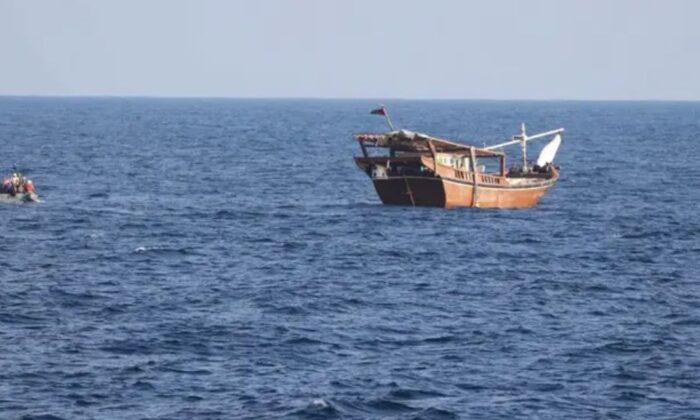The U.S. Navy seized thousands of AK-47 rifles after stopping a suspected smuggling vessel on its way from Iran to Yemen, the Navy confirmed Tuesday.
“This shipment is part of a continued pattern of destabilizing activity from Iran,” said Vice Adm. Brad Cooper, commander of U.S. Naval Forces Central Command, U.S. 5th Fleet and Combined Maritime Forces. “These threats have our attention. We remain vigilant in detecting any maritime activity that impedes freedom of navigation or compromises regional security.”
According to the statement, the intercepted vessel was sailing on a route historically used to traffic illicit weapons and cargo to Yemen’s Houthi rebels, considered allies of Tehran. Since November, the U.S. 5th Fleet also has intercepted two other fishing vessels in the Gulf of Oman smuggling weapons from Iran to Yemen.
“When we intercepted the vessel, it was on a route historically used to traffic illicit cargo to the Houthis in Yemen,” Hawkins told The Associated Press Tuesday. “The Yemeni crew corroborated the origin.”
The Yemeni crew, Hawkins added, will be repatriated back to a government-controlled part of Yemen. A United Nations arms embargo has prohibited weapons transfers to the Houthis since 2014 when Yemen’s civil war erupted.
“The direct or indirect supply, sale or transfer of weapons to the Houthis violates U.N. Security Council Resolution 2216 and international law,” said the Navy statement. “The transfer of the vessel and its crew for repatriation is in progress.”
History
Iran has long denied arming the Houthis even as it has been transferring rifles, rocket-propelled grenades, missiles, and other weaponry to the Yemeni militia using sea routes. Independent experts, Western nations, and U.N. experts have traced components seized aboard other detained vessels back to Iran.Iran’s mission to the United Nations or Iranian officials have not issued public comments on the U.S. Navy’s arms seizure.
The Houthis seized Yemen’s capital, Sanaa, in September 2014 and forced the internationally recognized government into exile. A Saudi-led coalition entered the war on the side of Yemen’s exiled government in March 2015. Years of inconclusive fighting has pushed the Arab world’s poorest nation to the brink of famine.
A six-month cease-fire in Yemen’s war, the longest of the conflict, expired in October despite diplomatic efforts to renew it. That’s led to fears the fighting could again escalate. More than 150,000 people have been killed in Yemen during the conflict, including over 14,500 civilians.
There have been sporadic attacks since the cease-fire expired, though international negotiators are trying to find a political solution to the war.
“The Iranian vessel attempted to blind the bridge by shining a spotlight and crossed within 150 yards of the U.S. ships—dangerously close, particularly at night,” said a statement from CENTCOM in early December. “The U.S. ships safely deescalated the situation through the [use] of audible warnings and non-lethal lasers. U.S. Navy ships continued their transit without further incident.”
Weeks before that, a suspected Iranian explosive attack drone hit a merchant ship near the coast of Oman, U.S. 5th Fleet also said.





